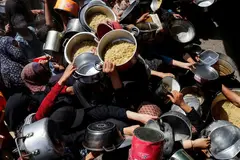WFP begins rapid food aid scale-up in Gaza as ceasefire takes hold
Key takeaways
- WFP launches a massive Gaza food aid scale-up, restoring 145 distribution points to reach 1.6 million people.
- Expanded efforts include tripling bakeries, delivering 100,000 bread bundles daily, and supporting vulnerable families through digital cash transfers.
- Success depends on secure ceasefire, open access, and coordinated logistics to rebuild Gaza’s devastated food systems sustainably.
As the effects of the ceasefire begin to settle over Gaza, the World Food Programme (WFP) reveals it is moving swiftly to turn the pause in fighting into a lifeline. For the first time in months, humanitarian corridors are opening — and with them, the chance to reach millions of Palestinians cut off from basic sustenance after two years of devastating conflict.
According to the WFP, the territory’s food systems lie in ruins. Markets are bare, supply chains have been shattered, and hundreds of thousands of families remain displaced.
Now, WFP is launching a large humanitarian scale-up in an attempt to restore a full food distribution network across 145 points throughout the Gaza Strip. In the next three months alone, the agency plans to reach 1.6 million people — roughly 320,000 families — with wheat flour, bread, and food parcels.

“The World Food Program has been calling for a ceasefire for a long time,” Antoine Renard, the WFP’s Palestine country director, attests. “The people of Gaza have been desperately waiting for this moment — they have been displaced multiple times, chased by the threat of hunger and malnutrition, and making impossible choices to survive.”
“Ceasefires open the way. The WFP will bring in the lifelines, and we are already scaling up. We restarted the bakeries last Sunday. More than 100,000 bundles of fresh bread are being provided daily as we speak to families in Gaza. With access, we can bring in the supplies in a big volume.”
The scale-up comes just after a study by the UN Relief and Works Agency and partners revealed findings showing that 54,000 children in Gaza are acutely malnourished in what the WHO director-general called a “man-made” mass starvation.
Expanding nutrition aid
The expansion includes tripling the number of supported bakeries from ten to thirty, which WFP says will dramatically increase access to fresh bread. Already, it notes that 100,000 bundles of bread — 2 kg each — are being baked daily for communities in need.
Alongside staple food aid, WFP is intensifying nutritional support for pregnant and breastfeeding women who are unable to travel to food distribution centers. WFP states that for those unable to reach food distribution centers, including widows, single mothers, the elderly, and people with disabilities, digital payment programs have become a critical lifeline.
These cash transfers allow families to purchase food locally and help support small markets that have survived the conflict. So far, 140,000 people have benefited, and WFP says it will double that number in the coming weeks.
Ceasefire offers fragile opportunity
The agency also leads the logistical backbone of Gaza’s wider humanitarian effort — coordinating food security operations, emergency telecommunications, and supply chains for partner organizations. More than 170,000 metric tons of WFP-managed food commodities are now poised for delivery, which it says is enough to feed Gaza’s entire population of over two million for up to three months.
However, WFP notes that this ambitious operation hinges on secure access, repaired infrastructure, and faster clearance protocols at key entry points like Ashdod.
“We must act now — there is no time to waste,” the agency stresses.
The ceasefire offers a window to rebuild systems of survival if it holds. A ceasefire was also met in January of this year, but it quickly broke down. In July, famine reached such high levels that Israel called a momentary humanitarian pause.
WFP says success will depend on logistics, coordination, and stability. It further notes that only with sustained peace and open access can it deliver at the scale required by a crisis of this magnitude.

















